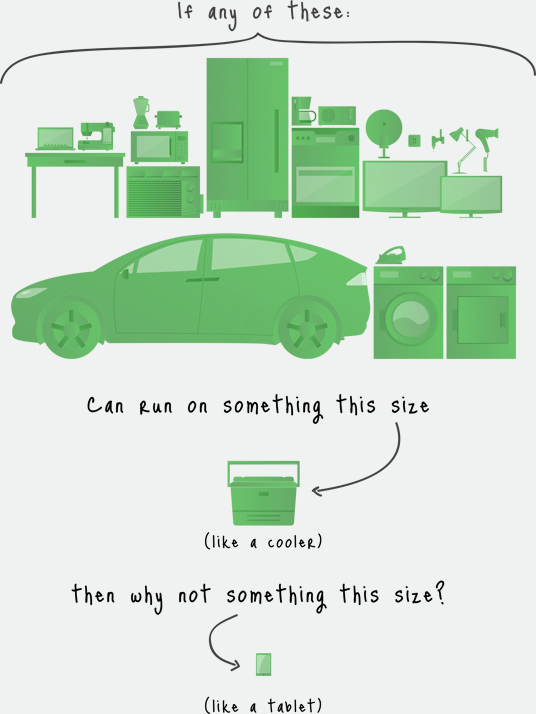Google wants to provide today’s homeowner with big time ‘green’ power in smaller sized packages, and it’s hoping a million dollar carrot will be enough to entice electrical engineers and designers the world over to come up with a worthwhile, marketable solution.

To ensure they’re reaching the right audience, Google teamed up with the Institute of Electrical and Electronic Engineers to create the “Littlebox Challenge”. In short, the purpose of the contest is to find the best design for a device no bigger than the smallest of small laptops (tablet sized ideally), which can efficiently convert the direct current power generated from solar or wind energy, into alternating current power which can be used in homes and businesses.

The large-scale inverters presently in place for converting direct current to alternating current are complex and use sources like fossil or nuclear fuels. There are plenty of problems associated with the way these plants are set up, much of which is common knowledge and needs no further assessing.

Smaller, household inverters, meanwhile, are still too big to be seen as a worthwhile purchase in the eyes of the common homeowner (they’re approximately the size of a picnic cooler). Google believes that by making them about a tenth of the size, and giving the device the ability to convert clean, natural resources like solar and wind energy into electricity, would make people more inclined to purchase the device.

Sure, the result of this would be profitable for Google, but it would also enable more solar-powered homes, lead to more efficient distributed electrical grids, and bring electricity to more parts of the world.
“There will be obstacles to overcome; like the conventional wisdom of engineering,” Eric Raymond of the Google Green Team said in an online post announcing the challenge. “But whoever gets it done will help change the future of electricity.”
In terms of the specifics regarding what Google wants the inverter to do, here’s an abbreviated check list from the contest site:
• Must be able to handle up to 2 kVA loads
• Must achieve a power density of equal to or greater than 50 W/in3
• Must be able to handle loads with power factors from 0.7–1, leading and lagging in an islanded mode
• Must be in a rectangular metal enclosure of no more than 40 in3
• Will be taking in 450 V DC power in series with a 10 Ω resistor
• Must output 240 V, 60 Hz AC single phase power
• Must have a total harmonic distortion + noise on both voltage and current of • Must have an input ripple current of • Must have an input ripple voltage of • Must have a DC-AC efficiency of greater than 95%
• Must maintain a temperature of no more than 60°C during operation everywhere on the outside of the device that can be touched.
• Must conform to Electromagnetic Compliance standards as set out in FCC Part 15 B
• Cannot use any external source of cooling (e.g. water) other than air
• Does not require galvanic isolation
The company also explained how it will go about judging entries:
Our testing philosophy is to not look inside the box. You provide us with a box that has 5 wires coming out of it: two DC inputs, two AC outputs and grounding connection and we only monitor what goes into and comes out of those wires, along with the temperature of the outside of your box, over the course of 100 hours of testing.
The full, 29-page document that lays out all of the requirements can be downloaded here.
Looking to give contestants a head start, Google describes on the contest site how one set of new technologies which might help engineers achieve higher power densities in smaller designs are wide bandgap semiconductors, including Gallium Nitride and Silicon Carbide. They then list a number of manufacturers who made pages describing their approach to this technology, and how it might help contestants win the competition.
These manufacturers include:
CREE
EPC
GaN Systems
Monolith Semiconductor
NXP
ROHM
transphorm
USCi
A winning design is expected to be picked by January 2016. If you are interested in joining, here’s how the contest timeline is laid out:
September 2014
• Applicants contemplating competing in the prize must register their team by the registration deadline: September 30, 2014.
• Eligible academics interested in pursuing grant funding must apply by the grant application deadline: September 30, 2014 by visiting the University Relations site.
July 2015
• Registered teams must submit a technical approach and testing application by July 22, 2015.
October 2015
• Up to 18 finalists will be notified of their selection for final testing at the testing facility. They are required to bring their inverters in person to a testing facility in United States by October 21, 2015.
January 2016
• The grand prize winner will be announced.
To register, or to learn more about the LittleBox Challenge, you can head to the contest site at littleboxchallenge.com
Advertisement
Learn more about Electronic Products Magazine





